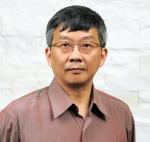Self-diffusion of adatoms and dimers on fcc(100) surfaces
- Citation:
- Chang, C. M., & Wei C. M. (2005). Self-diffusion of adatoms and dimers on fcc(100) surfaces. Chinese Journal of Physics. 43, 169-175., Feb, Number 1
Abstract:
Using ab initio density-functional theory, the self-diffusion of adatom and dimer on fcc(100) metal surfaces are studied. For adatom diffusion, we find that the exchange mechanism is favored for Al, Ir, Ni, Pd, Pt and Au, while the hopping mechanism is favored for Rh, Cu, and Ag. Except for Ir/Ir(100), the exchange diffusion energy has a surprising large size-effect and decreases as the surface unit cell increases. This is due to the long-ranged strain-field created at the exchange transition state, which needs a larger cell to relax. The hopping diffusion energy, on the other hand, has a very small size-effect and keeps approximately the same value for various surface unit cells. For self-diffusion on lr(100), the formation of covalent bonds are found at the exchange transition state, and thus the exchange diffusion energy has a little size-effect. Our results also indicate that the exchange mechanism is energetically more favorable for dimer diffusion on fcc(100) surface whenever it is favored for adatom diffusion on fcc(100) surface.
Notes:
ISI Document Delivery No.: 902JKTimes Cited: 8Cited Reference Count: 26Cited References: AYRAULT G, 1974, J CHEM PHYS, V60, P281, DOI 10.1063/1.1680781 BASSETT DW, 1978, SURF SCI, V70, P520, DOI 10.1016/0039-6028(78)90429-6 CEPERLEY DM, 1980, PHYS REV LETT, V45, P566, DOI 10.1103/PhysRevLett.45.566 Chang CM, 2001, J PHYS-CONDENS MAT, V13, pL321, DOI 10.1088/0953-8984/13/17/101 CHEN CL, 1990, PHYS REV LETT, V64, P3147, DOI 10.1103/PhysRevLett.64.3147 Feibelman PJ, 1999, PHYS REV B, V59, P5892, DOI 10.1103/PhysRevB.59.5892 FEIBELMAN PJ, 1990, PHYS REV LETT, V65, P729, DOI 10.1103/PhysRevLett.65.729 Fu TY, 2000, SURF SCI, V454, P571, DOI 10.1016/S0039-6028(00)00095-9 Fu TY, 1999, SURF SCI, V421, P157, DOI 10.1016/S0039-6028(98)00847-4 Hohenberg P., 1964, PHYS REV B, V136, P864 KELLOGG GL, 1994, SURF SCI REP, V21, P1, DOI 10.1016/0167-5729(94)90007-8 KELLOGG GL, 1991, PHYS REV LETT, V67, P622, DOI 10.1103/PhysRevLett.67.622 KELLOGG GL, 1990, PHYS REV LETT, V64, P3143, DOI 10.1103/PhysRevLett.64.3143 KELLOGG GL, 1991, J VAC SCI TECHNOL A, V9, P1757, DOI 10.1116/1.577457 Kresse G, 1996, PHYS REV B, V54, P11169, DOI 10.1103/PhysRevB.54.11169 Kresse G, 1996, COMP MATER SCI, V6, P15, DOI 10.1016/0927-0256(96)00008-0 KRESSE G, 1993, PHYS REV B, V47, P558, DOI 10.1103/PhysRevB.47.558 KRESSE G, 1994, J PHYS-CONDENS MAT, V6, P8245, DOI 10.1088/0953-8984/6/40/015 KRESSE G, 1994, PHYS REV B, V49, P14251, DOI 10.1103/PhysRevB.49.14251 Lundqvist S., 1983, THEORY INHOMOGENEOUS MONKHORST HJ, 1976, PHYS REV B, V13, P5188, DOI 10.1103/PhysRevB.13.5188 Perdew J. P., 1991, ELECT STRUCTURE SOLI PICKETT WE, 1989, COMPUT PHYS REP, V9, P115, DOI 10.1016/0167-7977(89)90002-6 TRINGIDES MC, 1997, SURFACE DIFFUSION AT Yu BD, 1997, PHYS REV B, V56, pR15569, DOI 10.1103/PhysRevB.56.R15569 Zangwill A., 1988, PHYS SURFACESChang, CM Wei, CM6th Taipei Symposium on Surfaces, Thin Films and NanosciencesAUG 17-20, 2004Taipei, TAIWANNatl Taiwan Univ, Acad SinicaPHYSICAL SOC REPUBLIC CHINATAIPEIPart 2

